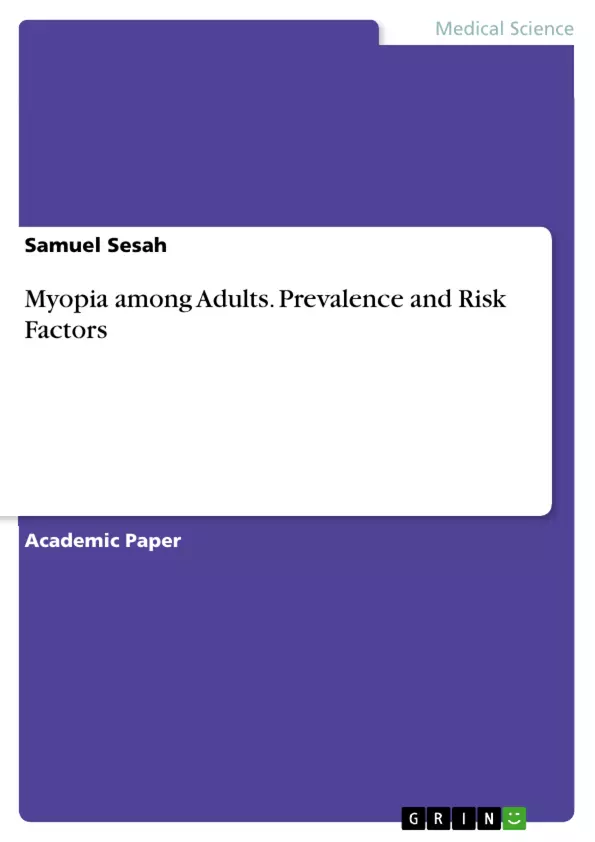Today, with increasing level of education and living standard, the prevalence & severity of myopia appear to be an upward trend. Although the mechanisms of development and progression of myopia remain uncertain, environmental factors such as a higher level of education, more near-work, and lesser outdoor activities, could be associated with myopia. This study sought to investigate the prevalence and risk factors of myopia among KNUST students in Kumasi- Ghana.
In this cross-sectional study, 307 Students of KNUST aged between 17 and 35 years were randomly recruited. Information on near work, indoor and outdoor activities and well as sleep duration and habits and use of visual aids was obtained using myopia risk factor questionnaire. Non-cycloplegic refraction was performed using autorefraction technique. Myopia was defined as spherical equivalent refraction (SER) ≤-0.50 D. Data were analyzed for 307 (male: 155 and female: 152) students with full relevant data.
Inhaltsverzeichnis (Table of Contents)
- CHAPTER ONE INTRODUCTION
- BACKGROUND
- PROBLEM STATEMENT
- JUSTIFICATION
- RESEARCH QUESTIONS
- PRINCIPAL OBJECTIVE
- SPECIFIC OBJECTIVES
- CHAPTER TWO: METHODOLOGY
- STUDY AREA
- STUDY DESIGN
- STUDY POPULATION
- SAMPLE SIZE
- SAMPLING TECHNIQUE
- DATA COLLECTION TOOL
- VALIDITY
- RELIABILTY
- INCLUSION CRITERIA
- EXCLUSION CRITERIA
- DATA COLLECTION METHOD
- DATA ANALYSIS AND STATISTICAL METHOD
- WORK PLAN
- BUDGET
- ETHICAL CONSIDERATION
- CHAPTER THREE: RESULTS
- Objective 1: Prevalence and distribution patterns of myopia among students in KNUST.
- Objective 2: Extent of engagement in near work activities
Zielsetzung und Themenschwerpunkte (Objectives and Key Themes)
This study aims to investigate the prevalence and risk factors of myopia among students at KNUST in Kumasi, Ghana. It seeks to contribute to the understanding of this growing public health concern, particularly in a setting with increasing educational attainment and near-work demands.
- Prevalence of myopia among KNUST students
- Risk factors associated with myopia
- Impact of near-work activities on myopia development
- Influence of outdoor activities and smartphone usage on myopia
- Socio-demographic factors associated with myopia
Zusammenfassung der Kapitel (Chapter Summaries)
Chapter One provides a comprehensive introduction to the topic of myopia, highlighting the increasing prevalence and its potential association with environmental factors. It outlines the study's objectives and research questions. Chapter Two delves into the methodology, detailing the study design, sample size, data collection methods, and ethical considerations. This chapter lays the groundwork for the research and ensures methodological rigor. Chapter Three presents the findings of the study, focusing on the prevalence of myopia among students at KNUST and the association of various factors with myopia development.
Schlüsselwörter (Keywords)
Myopia, prevalence, risk factors, near-work, outdoor activities, smartphone usage, students, KNUST, Ghana, public health, environmental factors.
- Citation du texte
- Samuel Sesah (Auteur), 2023, Myopia among Adults. Prevalence and Risk Factors, Munich, GRIN Verlag, https://www.grin.com/document/1322875



